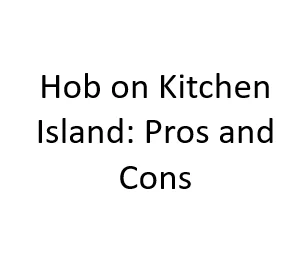As kitchen design trends continue to evolve, the incorporation of functional and stylish elements becomes essential. One such trend that has gained significant attention in recent years is the addition of a hob on the kitchen island. This innovative concept has sparked conversations among homeowners, designers, and culinary enthusiasts alike. In this blog post, we’ll delve into the world of kitchen islands with hobs, discussing their pros and cons to help you make an informed decision for your own kitchen space.
Pros:
- Enhanced Social Interaction: Placing a hob on the kitchen island opens up the space and encourages interaction between the cook and guests or family members. It transforms cooking into a social activity, allowing the chef to engage in conversations while preparing meals.
- Efficient Workflow: Having a hob on the island can create a more streamlined cooking process. Ingredients and utensils are within easy reach, reducing the need to move back and forth between different kitchen stations.
- Aesthetics and Focal Point: The hob on the kitchen island can serve as a striking focal point, elevating the overall aesthetic of the kitchen. It adds a touch of modernity and sophistication that can make your kitchen stand out.
- Flexible Seating Arrangements: Kitchen islands with hobs often come with built-in seating options like bar stools. This provides a casual dining spot for quick meals or a place to sit and chat while cooking is in progress.
- Open Space Feeling: A hob on the kitchen island can make your kitchen appear more spacious and open, especially when compared to traditional kitchen layouts where the hob is against a wall.
Cons:
- Ventilation Challenges: Proper ventilation is crucial when cooking on a hob, and having it on the island can pose challenges. Installing a suitable ventilation system can be complex and costly.
- Limited Countertop Space: While the island offers a convenient cooking spot, it may reduce the available countertop space for other kitchen activities such as meal prep, baking, and organizing kitchen appliances.
- Safety Concerns: Placing a hob in the middle of the kitchen might raise safety concerns, especially if there are children in the household. Hot surfaces and open flames can be more accessible to little hands.
- Cooking Odors: Cooking odors and steam from the hob can spread more easily throughout the kitchen and other living areas when it’s situated on the island. This might require investing in a high-quality exhaust system.
- Installation and Utility Connections: Installing a hob on the island may require adjustments to utility connections like gas, electricity, and plumbing. This can be logistically challenging and add to the overall renovation cost.
Design Tips for a Functional and Stylish Kitchen Island with a Hob
If you’ve decided to take the plunge and incorporate a hob on your kitchen island, you’re in for an exciting journey of transforming your culinary space. To help you make the most of this innovative design choice, here are some practical and aesthetic tips to consider:
1. Prioritize Ventilation:
As mentioned earlier, proper ventilation is crucial when it comes to a hob on the kitchen island. Investing in a high-quality range hood or downdraft system is essential to keep your kitchen air clean and free from cooking odors. Consult with professionals to determine the most effective ventilation solution for your kitchen layout.
2. Select the Right Hob Type:
There are various hob options available, including gas, electric, and induction hobs. Each type has its own set of advantages and considerations. Induction hobs, for example, are known for their fast heating and precise temperature control, while gas hobs offer a classic cooking experience. Choose a hob type that aligns with your cooking style and preferences.
3. Plan for Adequate Countertop Space:
While the hob is a central feature, don’t compromise on the amount of available countertop space. Design the island in a way that provides ample room for meal preparation, chopping, and other kitchen activities. Consider incorporating a chopping board or pull-out work surface adjacent to the hob for added convenience.
4. Integrate Storage Solutions:
Utilize the island’s base for storage solutions that complement your cooking needs. Drawers, shelves, and cabinets can house pots, pans, utensils, and even cooking spices. Having a well-organized storage system within arm’s reach of the hob can significantly enhance your cooking efficiency.
5. Create a Cohesive Design:
Harmonize the island’s design with the rest of your kitchen. Coordinate the materials, colors, and finishes to ensure a seamless transition between the island and the surrounding kitchen elements. This cohesiveness contributes to an overall aesthetically pleasing look.
6. Illuminate with Purpose:
Proper lighting is key when cooking, so consider installing pendant lights or adjustable spotlights above the island. These lights not only provide functional illumination for cooking but also contribute to the island’s visual appeal.
7. Incorporate Seating:
If space permits, integrate seating options around the island. Whether it’s bar stools or built-in benches, having seating nearby encourages social interaction and turns the island into a versatile hub for dining and entertaining.
8. Account for Safety:
To address safety concerns, consider installing safety features such as childproof locks and heat-resistant barriers to keep little ones away from hot surfaces. Additionally, positioning the hob away from the edge of the island can create a buffer zone between the cooking area and seating.
9. Personalize the Island’s Function:
Customize the island’s features to suit your cooking style. If you’re an avid baker, you might want to incorporate a built-in oven within the island. Alternatively, if you love experimenting with international cuisines, consider a wok burner or a teppanyaki plate.
10. Seek Professional Guidance:
Designing a kitchen island with a hob requires careful planning and execution. Enlist the expertise of a kitchen designer or architect who can help you navigate the intricacies of layout, utility connections, and aesthetics. Their experience can ensure that your vision aligns with functional practicality.
Incorporating a hob on the kitchen island can transform your culinary space into a hub of activity, style, and functionality. By considering these design tips and collaborating with professionals, you can create a kitchen island that not only enhances your cooking experience but also elevates the overall ambiance of your home. So, roll up your sleeves, let your creativity flow, and embark on a kitchen design journey that’s as exciting as it is rewarding.

